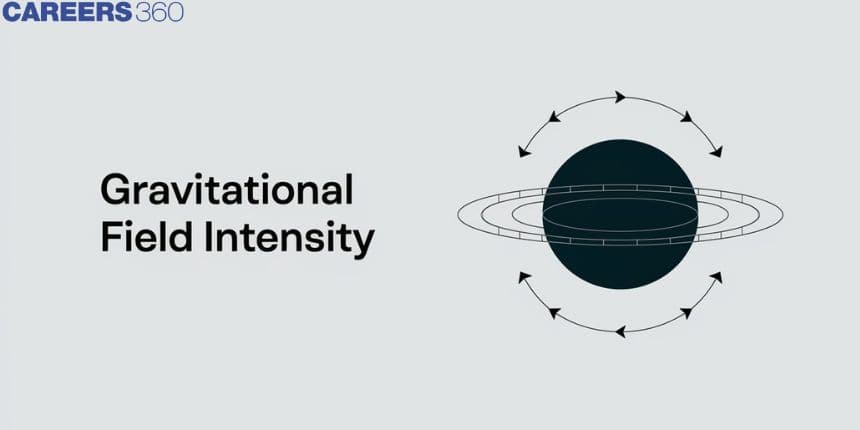Gravitational Field Intensity
Gravitational field intensity is a measure of the force exerted by gravity at a particular point in space. It describes how strong the gravitational force is at that point, typically expressed in units of N/kg (Newtons per kilogram). Understanding gravitational field intensity helps us comprehend the influence of gravity on objects, whether they're near the Earth's surface or in space. This concept is essential for explaining why objects fall towards the Earth, how planets orbit the sun, and many other phenomena governed by gravity. This article will delve into the principles of gravitational field intensity, with solved examples to enhance your understanding.
This Story also Contains
- What is a Gravitational Field?
- What is Gravitational Field Intensity?
- Solved Examples Based on Gravitational Field Intensity
- Summary

What is a Gravitational Field?
A gravitational field is a region of space surrounding a mass in which another mass experiences a force of attraction. It is a vector field, meaning it has both magnitude and direction, and is represented by the gravitational field strength (denoted by g), which is the force per unit mass exerted on a small test mass placed within the field.
What is Gravitational Field Intensity?
It is the force experienced by a unit mass at a point in the field. It is denoted by I. If the mass of a body is m then I is given by:
I→=F→mI→→ G.field Intensity m→ mass of object f→→ Gravitational Force
More About Gravitational Field Intensity
It is a vector quantity
If the field is produced by a body M the direction of its Gravitational field Intensity is always towards the center of gravity of M.
Unit: Newton kg or ms2
Dimension : [M0LT−2]
Recommended Topic Video
Solved Examples Based on Gravitational Field Intensity
Example 1: The mass density of a spherical body is given by ρ (r) = kr for r ≤ R and ρ (r)=0 for r > R, where r is the distance from the centre. The correct graph that describes qualitatively the acceleration, a, of a test particle as a function of r is
1)

2)

3)

4)

Solution:
Given that,
p=mv of spherical body P(r)=kr
mv=kr for inside r⩽R
m=kvr……………..
inside the surface of the sphere, the intensity
I=GmrR3∵I=Fmginside =Gm3Rr or I=mgm=g=GR3kvrr= constant from equation (1) gout =Gmr2
Hence, the answer is the option (1).
Example 2: Which of the following statements about the variation of gravitational field strength is true?
1) It increases as we go above the surface of the earth
2) It increases as we go below the surface of the earth
3) Its magnitude is maximum at the surface of the earth
4) None of the above is true
Solution:
Gravitational field Intensity
It is the force experienced by a unit mass at a point in the field.
It is denoted by I
If the mass of a body is M then I is given by
I→=F→mI→=GMr2r^I→∝1r2
I is maximum at the surface of the earth.
For a test mass gravitational force acting due to earth is mg
So gravitational field strength will be equal to the g value.
So the value of the gravitational field strength is maximum at the surface of the earth.
Hence, the answer is the option (3).
Example 3: What is the unit of gravitational-field Intensity?
1) Unit: Newton kg
2) Unit: ms2
3) Unit : Newton 2 kg
4) Both of A and B
Solution:
If the mass of a body is m then Gravitational-field Intensity I is given by
I→=F→m Unit: Newton kg or ms2
Hence, the answer is the option(4).
Example 4:What is the dimension of Gravitational field Intensity :
1) [M0LT−2]
2) [M1LT−2]
3) [M2LT−2]
4) [M0L3T−2]
Solution:
Gravitational field Intensity I
It is the force experienced by a unit mass at a point in the field.
I→=F→m
The dimension of Gravitational field Intensity is : [M0LT−2]
Hence, the answer is the option(1).
Example 5: What is the effect of increasing the mass of an object on the strength of the gravitational field at a point in space?
1) It increases
2) Decreases
3) Remains constant
4) It depends on the distance from the object
Solution:
The intensity of the gravitational field at a point in space is directly proportional to the mass of the object creating the gravitational field, according to the formula g=Gmr2.
Therefore, increasing the mass of an object will also increase the intensity of the gravitational field at a point in space.
Hence, the answer is the option (1).
Summary
The phenomenon of gravity, or gravitation, is the attraction of all objects with mass or energy, such as galaxies, stars, planets, and lights. Earth's mass is given weight via gravity. The gaseous substance in the cosmos began to gravitationally attract one another to form stars, which then gathered into a galaxy. We can determine the intensity of the gravitational field by measuring the force that a unit mass experiences at any given level in the field. N kg-1 is the SI unit for gravitational field intensity. The intensity of the gravitational field is a scalar quantity.